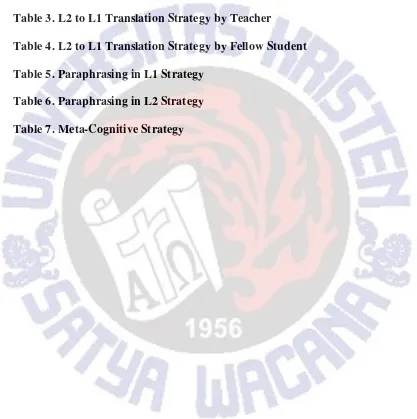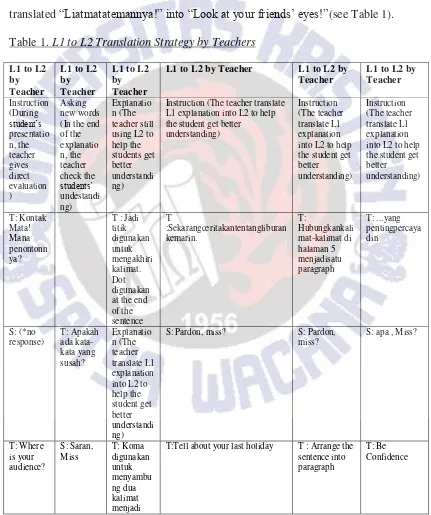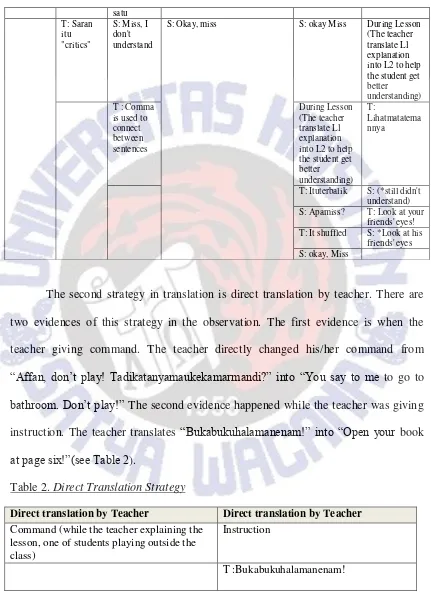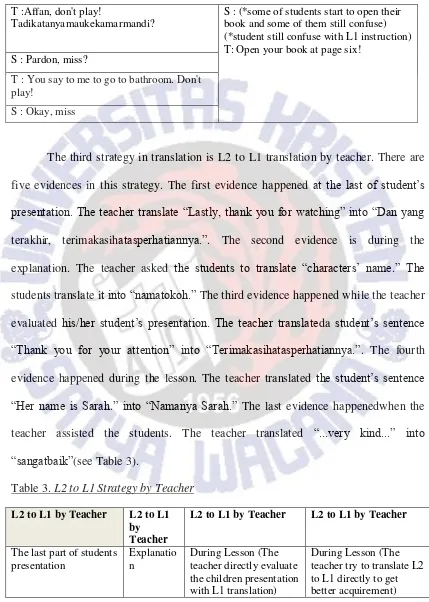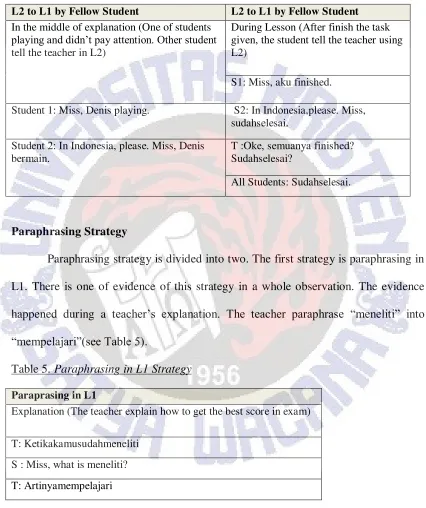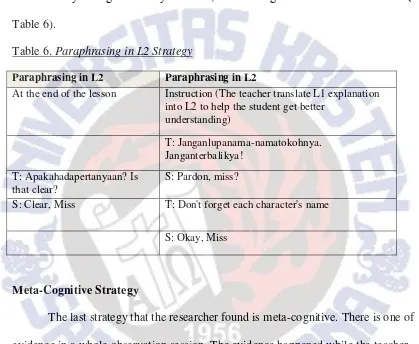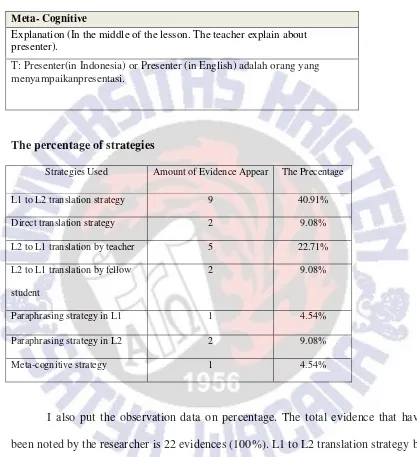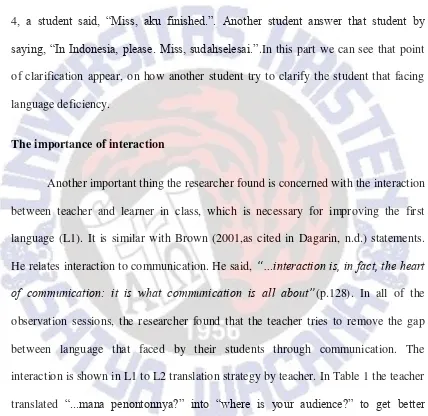Strategic Competence to Compensate Students’ Linguistic
Deficiencies: A Case Study in a Christian Primary School in Salatiga
THESIS
Submitted in Partial Fulfillment of the Requirements for the Degree of
SarjanaPendidikan
Dewi Ratoja D.W 112011070
ENGLISH DEPARTMENT
FACULTY OF LANGUAGE AND LITERATURE
SATYA WACANA CHRISTIAN UNIVERSITY
SALATIGA
Strategic Competence to Compensate Students’ Linguistic
Deficiencies: A Case Study in a Christian Primary School in Salatiga
THESIS
Submitted in Partial Fulfillment of the Requirements for the Degree of
SarjanaPendidikan
Dewi Ratoja D.W 112011070
ENGLISH DEPARTMENT
FACULTY OF LANGUAGE AND LITERATURE
SATYA WACANA CHRISTIAN UNIVERSITY
COPYRIGHT STATEMENT
This thesis contains no such material as has been submitted for examination in any course or accepted for the fulfillment of any degree or diploma in any university. To the best of my knowledge and my belief, this contains no material previously
published or written by any other person except where due reference is made in the text.
Copyright@ 2014. Dewi Ratoja D.W and Joseph Ernest Mambu, S.Pd., M.A, Ph.D.
All rights reserved. No part of this thesis may be produced by any means without the permission of at least one of the copyright owners or the English Department, Faculty of Language and Literature, SatyaWacana Christian University, Salatiga.
TABLE OF CONTENT
COVER PAGE...i
APPROVAL FORM...ii
COPYRIGHT STATEMENT...iii
PUBLICATION AGREEMENT DECLARATION...vi
ABSTRACT...1
I.INTRODUCTION...1
II.THEORETICAL FRAMEWORK...2
CLT in Asean Countries...3
Celce Murcia’s Communicative Strategies...4
III.THE STUDY...5
Context of Study...5
Participants...5
Data Collection Procedure...6
Data Analysis Procedure...7
IV.FINDINGS AND DISCUSSION...7
Translation Strategies...7
Paraphrasing Strategy...12
Meta-Cognitive Strategy...13
The Precentage of Strategy...14
V.CONCLUSION...20
VI.ACKNOWLEDGEMENT...23
VII.REFERENCES...24
LIST OF TABLES
Table 1. L1 to L2 Translation Strategy by Teacher
Table 2. Direct Translation Strategy by Teacher
Table 3. L2 to L1 Translation Strategy by Teacher
Table 4. L2 to L1 Translation Strategy by Fellow Student
Table 5. Paraphrasing in L1 Strategy
Table 6. Paraphrasing in L2 Strategy
Strategic Competence to Compensate Students’ Linguistic
Deficiencies: A Case Study in a Christian Primary School in Salatiga
ABSTRACT
Nowadays English exposure is high especially in school. In Indonesia, the number of schools that use English as Medium of Instruction(EMI) is increasing. This condition makes students face several linguistic deficiencies. Some of them speak English every time and forget how to speak in Bahasa Indonesia. This study aimed to find the strategic competence that can be used to compensate linguistic gaps or difficulties at a primary school level. The strategic competence by Celce Murcia(2007) became the main theoretical framework for this study. The study is qualitative that used one type of data collection, which is observation. The study would be held in Christian Elementary School in Salatiga. The researcher would have eight classroom sessions of observation in Bahasa Indonesia classes. The second until fourth grade will be the focus of this study. Findings suggest that the teachers and their studentsused their own strategies to compensate the deficiencies. Those strategies are translation, paraphrasing and meta-cognitive. Some implications for pedagogy and further research are suggested.
Key words: L1, Linguistic deficiencies, Strategic competence
INTRODUCTION
Communicative Language Teaching(CLT) is a very popular method in teaching learning activity. As Jarvis, as cited in Kustati (2013, p. 267), put it: “[The]
current trend in the teaching of EFL in Southeast Asia has given emphasis on communicative language teaching (CLT) as one of the innovative methods within the last quarter of a century.” The aim of this language teaching approach is to encourage
cited in Celce-Murcia, 2007). The first is Grammaticalcompetence. It isthe knowledge of the language code. The second is Sociolinguistic competence—the mastery of the sociocultural code of language use. The third is Discourse competence—the ability to combine language structures into different types of cohesive texts. The last is Strategic competence—the knowledge of verbal and non-verbal communication strategies which enhance the efficiency of communication.
The current study will focus on teachers’ strategic competence in addressing the students’ first language (L1) linguistic deficiencies. In one of Christian
Elementary School in Salatiga (CESS), the Indonesian students have been exposed with English through the school’s immersion program. Therefore, they tend to master English, as the second language (L2), rather than Bahasa Indonesia, which is supposed to be their first language(L1). Some of them have difficulties in L1 structure and expression. That is why in this study that problem will be discussed. However, the focus of this study is not yet discussed in the CLT literature. Most CLT studies attempt to answer how the CLT approach is viewed and implemented in various Asian countries (Kwangsawad, 2007; Mustafa, 2001; Nur, 2003; and Van, 2008) in the context of ELT. These current studies have not discussed much on how knowledge of components of communicative competence, especially strategic competence, can be useful for learners, regardless of the teachers’ or schools’
LITERATURE REVIEW
Theoretical Framework
CLT in ASEAN Countries
In several of Asian countries such as China, Bangladesh, Vietnam, Thailand and Indonesia, the reasons of difficultiesin CLT implementation are similar. The first difficulty is misconception of CLT implementation. The second difficulty is teachers’ lack of teaching repertoire. In Vietnam, Van (2008 as cited in Kustati, 2013) “states that the implementation of CLT faces three challenges in Vietnamese schools: the Vietnamese traditional culture of learning; teachers’ limited professional development and the constraints ofthe curriculum”(p.271).
in a class. Lewis(1996) said that most learners are passive in classes that attempt to utilize CLT. The fifth, in certain condition like what happen in Christian Elementary School in SalatigaCESS, the L1 deficiencies became the main reason of difficulty in CLT implementation. However, there is no study that focuses on that particular difficulty. That is why in this study, the researcher want to make a case for studies in the use of strategic competence to learn L1 since this case is not yet explored in the literature. The current study from Szulc-Kurpaska(2000) explain about English as Foreign Language(EFL) learners that have difficulties in speaking English. Another study is from McGrath (2013). His research participants are English Language Learner(ELL) in Kindergarten. However in his study, the difficulty is second language acquisition.
Celce-Murcia’s Communicative Strategies
Actually there are several strategies that can be used to compensate students learning deficiencies through strategic competence. Strategic competence is one of the components of communicative competence (Celce-Murcia,Dörnyei, &Turrel, 1995, as cited in Soler&Jordà, 2007).
Achievement:strategiesof approximation, circumlocution,
codeswitching,miming, etc.
Stalling or time gaining: using phrases like Where was I? Could yourepeat
that?
Self-monitoring: using phrases that allow for self-repair like I mean….
Interacting: these are strategies that include appeals forhelp/clarification, that
involve meaning negotiation, or that involvecomprehension and confirmation checks, etc.
Social: these strategies involve seeking out native speakers to practicewith,
actively looking for opportunities to use the target language.
THE STUDY
Context of the study
instead of Bahasa Indonesia. Ironically, BahasaIndonesia is the first language for all of the students but some of them have better acquisition in English.
Participants
The study will analyze on how the teachers compensate the gaps or deficienciesof students’ L1. The participantsincluded English teachers, Bahasa
Indonesia teachers and students in the second until the fourth grade (each grade has two classes).The researcher only observedIndonesian language teachers in Bahasa Indonesia classes because the problems appear in this course. The researcher interviewed the teachers if necessary, but not the students.However, the researcher still documented the students’ language use. There are three Bahasa Indonesia.
Teacher 1 for second graded, Teacher 2 for third graded and Teacher 3 for fourth graded.
Data Collection Procedure
to October 6, 2015. The observation was hold three times in second grade, two times in third grade and three times in fourh grade.
Data Analysis Procedure
I analyzed the teaching learning activity using Celce Murcia’s Strategic Competence as a reference. I categorized eachevidence of students’ deficiencies and teachers’ strategies used during the observation. The data will be discussed in the
next section of the study.
FINDINGS AND DICUSSION
The study on how the teachers compensate the gap or deficiencies of students’
L1
L1). The last strategy is meta-cognitive strategy (it is shown on how the teacher tries to explain grammatical functions of words using students’ L1 and L2. In the data collection of this study,Ifound that in the first day (in the 4th grade)the teacher used three communicative strategies.
Translation strategy
Translation strategy is divided into four. The first strategy is L1 to L2 translation by the teacher. This strategy appears nine times during eight sessions of observation. The first evidence is in the first day of observation, in the fourth grade. The teacher translated “Kontakmata! Mana penontonnya?” (Eye contact! Where is
the audience!)into “Where is your audience?”. The second evidence is when the teacher asked new words to check students’ understanding. The teacher translated “Saran” into “critics” [sic]. The third evidence is while the teacher explained a
lesson.The teacher translated “Jadititikdigunakanuntukmengakhirikalimat” (So, period is used to end asentence)into “Dot digunakan at the end of the sentence.”The fourth evidence is similar with the third evidence. The teachers translated “Komadigunakanuntukmenyambungduakalimatmenjadisatu” into “Comma is used to
connect between sentences” The fifth evidence is when the teacher gave instructions.The teacher translated “Sekarang, ceritakantentangliburankemarin” into “Tell about your last holiday.” The sixth evidence is similar with the fifth evidence.
eighth and ninth evidences happened during teacher explanation. Seventh, when the teacher translates “Ituterbalik!” into “It shuffled!” Eighth, when the teacher translate “....yang pentingpercayadiri” into “Be confident.” The last, when the teacher
translated “Liatmatatemannya!” into “Look at your friends’ eyes!”(see Table 1). Table 1. L1 to L2 Translation Strategy by Teachers
L1 to L2
Instruction (The teacher translate L1 explanation into L2 to help the student get better
understanding)
S: Pardon, miss? S: Pardon, miss?
T:Tell about your last holiday T : Arrange the sentence into paragraph
satu
T: Ituterbalik S: (*still didn't understand) teacher giving command. The teacher directly changed his/her command from “Affan, don’t play! Tadikatanyamaukekamarmandi?” into “You say to me to go to bathroom. Don’t play!” The second evidence happened while the teacher was giving
instruction. The teacher translates “Bukabukuhalamanenam!” into “Open your book at page six!”(see Table 2).
Table 2. Direct Translation Strategy
Direct translation by Teacher Direct translation by Teacher
Command (while the teacher explaining the lesson, one of students playing outside the class)
T :Affan, don't play!
Tadikatanyamaukekamarmandi?
S : (*some of students start to open their book and some of them still confuse) (*student still confuse with L1 instruction) T: Open your book at page six!
The third strategy in translation is L2 to L1 translation by teacher. There are five evidences in this strategy. The first evidence happened at the last of student’s presentation. The teacher translate “Lastly, thank you for watching” into “Dan yang
terakhir, terimakasihatasperhatiannya.”. The second evidence is during the explanation. The teacher asked the students to translate “characters’ name.” The students translate it into “namatokoh.” The third evidence happened while the teacher evaluated his/her student’s presentation. The teacher translateda student’s sentence “Thank you for your attention” into “Terimakasihatasperhatiannya.”. The fourth
evidence happened during the lesson. The teacher translated the student’s sentence “Her name is Sarah.” into “Namanya Sarah.” The last evidence happenedwhen the
teacher assisted the students. The teacher translated “...very kind...” into “sangatbaik”(see Table 3).
Table 3. L2 to L1 Strategy by Teacher
L2 to L1 by Teacher L2 to L1 by Teacher
L2 to L1 by Teacher L2 to L1 by Teacher
S : Lastly, thank you teacher assist the student to get better language expression in L1) There are two evidences in this strategy. The first evidence happened in the middle of teacher’s explanation. A student(S2), who is better at Bahasa Indonesia, corrected the
Table 4. L2 to L1 Translation by a Fellow Student
L2 to L1 by Fellow Student L2 to L1 by Fellow Student
In the middle of explanation (One of students
playing and didn’t pay attention. Other student
tell the teacher in L2)
During Lesson (After finish the task given, the student tell the teacher using L2)
S1: Miss, aku finished.
Student 1: Miss, Denis playing. S2: In Indonesia,please. Miss, sudahselesai.
Student 2: In Indonesia, please. Miss, Denis bermain.
T :Oke, semuanya finished? Sudahselesai?
All Students: Sudahselesai.
Paraphrasing Strategy
Paraphrasing strategy is divided into two. The first strategy is paraphrasing in L1. There is one of evidence of this strategy in a whole observation. The evidence happened during a teacher’s explanation. The teacher paraphrase “meneliti” into “mempelajari”(see Table 5).
Table 5. Paraphrasing in L1 Strategy
Paraprasing in L1
Explanation (The teacher explain how to get the best score in exam)
T: Ketikakamusudahmeneliti S : Miss, what is meneliti? T: Artinyamempelajari
teacher paraphrased “apakahadapertanyaan?” into “is that clear?” The second evidence happened while the teacher tried to explain “Janganlupanama -namatokohnya. Janganterbalikya!” in L2, “Don’t forget each character’s name.”(see
Table 6).
Table 6. Paraphrasing in L2 Strategy
Paraphrasing in L2 Paraphrasing in L2
At the end of the lesson Instruction (The teacher translate L1 explanation into L2 to help the student get better
understanding)
T: Janganlupanama-namatokohnya. Janganterbalikya!
T: Apakahadapertanyaan? Is that clear?
S: Pardon, miss?
S: Clear, Miss T: Don't forget each character's name
S: Okay, Miss
Meta-Cognitive Strategy
The last strategy that the researcher found is meta-cognitive. There is one of evidence in a whole observation session. The evidence happened while the teacher explained about presentation and a student asked the difference between “Presenter”
Table 7. Meta-Cognitive Strategy
Meta- Cognitive
Explanation (In the middle of the lesson. The teacher explain about presenter).
T: Presenter(in Indonesia) or Presenter (in English) adalah orang yang menyampaikanpresentasi.
The percentage of strategies
Strategies Used Amount of Evidence Appear The Precentage
L1 to L2 translation strategy 9 40.91%
Direct translation strategy 2 9.08%
L2 to L1 translation by teacher 5 22.71%
L2 to L1 translation by fellow
student
2 9.08%
Paraphrasing strategy in L1 1 4.54%
Paraphrasing strategy in L2 2 9.08%
Meta-cognitive strategy 1 4.54%
in the observation (4.54%). Paraphrasing strategy in L2 appears 2 times in the observation (9.08%). Meta-cognitive strategy appears once in the observation (4.54%).
Findings in View of Celce-
Murcia’s
Theoretical Framework
Interaction strategy
As the findings above suggest, translation was the most widely used strategy in class, especially, translation strategy from L1 to L2 by the teacher. This strategy was used in seven of eight sessions of observation. This strategy was used in giving instructions, giving explanation and asking new words. This strategy is therefore in line with interaction strategy by Celce Murcia(2007). It involves meaning negotiation when a student askedhis/her teacher about the words he/she did not understand and the teacher translated it into English (see Tables1, 2,3 and 4). Direct translation strategy also related to interaction strategy. This strategy demands comprehension from the students. The teacher will directly use this strategy to avoid students’ language misunderstanding. In Table 2 we can see that the students did not understand what his/her teacher said in Bahasa Indonesia. After the teacher translated it into L2, they say “Okay, miss.”. This expression shows that the student achieved a
language comprehension through direct translation strategy.
Table 3, a student asked the teacher “...Miss, what is very kind in Indonesia?”. This expression demands a confirmation from the teacher. Interaction strategy contains point of clarification. It is similar to L2 to L1 translation by fellow student. In Table 4, a student said, “Miss, aku finished.”. Another student answer that student by saying, “In Indonesia, please. Miss, sudahselesai.”.In this part we can see that point
of clarification appear, on how another student try to clarify the student that facing language deficiency.
The importance of interaction
Another important thing the researcher found is concerned with the interaction between teacher and learner in class, which is necessary for improving the first language (L1). It is similar with Brown (2001,as cited in Dagarin, n.d.) statements. He relates interaction to communication. He said, “…interaction is, in fact, the heart of communication: it is what communication is all about”(p.128). In all of the
The study of Szulc-Kurpaska (2000, as cited in Dagarin, n.d.) discussescommunication strategies of 35 eleven-year old children. In his study, communication strategies mainly used when interacting were the use of the mother tongue and body language. Some of the student repeated after the teacher (p.138). That condition is similar to findings in this study.The teacher helped students who face language deficiencies using the language they acquire better. The concrete example is shown in Table 3. The teacher translated their student’s statement “Thank you for your attention.” into “Terimakasihatasperhatiannya.”. After that the student repeated after the teacher.
Self-monitoring strategy
Another Celce-Murcia’s strategy appearing in this study is self monitoring strategy. The students in CESS seem to be active to repair themselves. The example is shown in Table number 3. The student said “Diasangatcantikdan....hmm... Miss, what is very kind in Indonesia?” and the teacher answer “Sangatbaik.”, then the student
repeated after the teacher. In the middle of students’ explanation, they asked the teacher about some words in Bahasa Indonesia that they do not understand.
Teacher as monitor
Beside self-monitoring strategy, the teacher also acts as a monitoring tool for the students. Flanders (1970, in Malamah-Thomas (1987, as cited in Dagarin, n.d.) stated that teacher roles are to monitor and clarify students’ language use by
communicative competence (p.131). This statement is in line with the findings in CESS classroom. The teacher seems to monitor the student and directly clarify them by translation and paraphrasing strategy. In Table 1 the researcher found that the teacher tried to monitor their students through checking student’s understanding. The teacher asked a difficult word. Then, he/she translate “Saran” into “critics.” In paraphrasing in L2 strategy (see Table 6), the teacher tried to check students understanding by asking a question in two language. The teacher asked “Apakahadapertanyaan?”, because there is no response from the students the teacher
CLT implementation in CESS
Mustafa(2001) argued that CLT has failed in Indonesia for several reasons. However in CESS, there is no problem with CLT implementation. The first reason why CLT can be implemented in CESS, even though there are still lack of teachers’ explanation, on how they translated “saran” into “critics” (see Table 1) and another imperfect translation, but the students seems to achieved a better understanding after those explanation. However, the researcher found that the teachers’ quality is not really important in CESS. Even if there are several mistakes of explanation happened, the students still got the meaning. Another reason is because the number of students in class. In CESS classes, there are only 15-20 students in a class. This condition might be the factor of CLT good implementation. The class condition is not too crowded and the teacher also gives enough attention for each student.
The researcher believes that the teachers are able to implement another strategic competence. However, in the whole observation, I only found three strategies:translation, paraphrasing and meta-cognitive. The first reason is the student’s ability. The student in this observation is still included in primary learner.
creates a limitation for the researcher to look for the strategies used by the teacher because her focus is divided between listening to teaching-learning activity and note taking.
CONCLUSION
Communicative Language Teaching (CLT) is a popular method in education. The aim of this language teaching approach is to encourage the learners to communicate effectively in a target language. The study aimed to investigate how the teachers compensate the linguistic gap or deficienciesof students’ L1 in CESS.The
participants are Bahasa Indonesia teacher and students in second grade to fourth grade.
The current studies around ASEAN countries have similar difficulties such as CLT misconception, the teachers’ quality, the first language effect, the class situation,
etc. This reason is the key of CLT failure in several countries. However, Celce Murcia (2007) has found several strategies that can compensate the teacher or learner difficulties. These strategies might be used by teacher and learner to gain CLT successful implementation.
but also in student-teacher interaction and student-student interaction. Besides that, the researcher found that paraphrasing and meta- cognitive strategy is also used in CESS, but not as much as translation strategy. In paraphrasing strategy, the interaction only happen in one way which is teacher-student interaction. It means that there is no active interaction in this strategy. The same case happens in meta-cognitive strategy.
However, this study is still has several limitations. First, CESS did not allow me to use video and audio recording in class observation. As a result, I only relied on note taking data in data analyze process.From this research, it can be seen that translation, paraphrasing, and meta-cognitive are good strategies to implement in Elementary or Primary Level. However, those three strategies can be explored more following the students’ need, the teachers’ ability and the class condition.
ACKNOWLEDGEMENT
References
Brown, D. H. (2001). Teaching by principles: an interactive approach to language pedagogy. White Plains, NY: Pearson Education.
Canale, M. (1983). From communicative competence to communicative language pedagogy. In J. C. Rithards&Schimdt, R. W. (Eds.). Language and communication. New York: Longman.
Celce-Murcia, M. (2007). Rethinking the role of communicative Competence in language teaching. In E. A. Soler & Jorda, M. P. S. (Eds.), Intercultural language use and language learning (pp. 41-58). Dordrecht: Springer.
Murcia, M. C., Dornyei, Z., &Thurrell, S. (1995). Communicative competence: A pedadogically motivated model with content specifications. Issues in Applied Linguistic, 6, 5-35.
Dagarin, M. (n.d.). Classroom Interaction and Communication Strategies in Learning English as Foreign Language. English Language and Literature Teaching, 128. Dagarin, M. (n.d.). Classroom Interaction and Communication Strategies in Learning
English as Foreign Language. English Language and Literature Teaching, 131 Dagarin, M. (n.d.). Classroom Interaction and Communication Strategies in Learning
English as Foreign Language. English Language and Literature Teaching, 138 Jarvis, H. &Atsilarat, S. (2004). Shiftingparadigms: from a communicative to a
context-based approach. Asian EFL Journal.
Kwangsawad, T. (2007). Bridging the gapbetween CLT and CBI theories and practices in Thai small rural schools. Paper presented at the International Conferences onEducational Reform 2001.
Kurpaska, M. S. (2000). Communication Strategies in 11-Years-Old. In Moon and Nikolov, 60, 345).
Kustati, M. (2013). The shifting paradigms in the implementation of CLTin Southeast Asia countries. Jurnal Al-Ta’lim, 1(4), 267-277.
course of a year, from
http://www.learnquebec.ca/en/content/curriculumelem/kinder/approaches/SecL ang/esl.Html
Mustafha, B. (2001). Communicative language teaching in Indonesia: issues of theoretical assumptions and challengesin the classroom. Journal of Southeast Asian Education,2, 19.
APPENDIX 1
Observation Fieldnotesin Eight Meetings at the Christian Elementary School in Salatiga
Meeting #1
N o
Date/Grade Strategy Used
Translation
L1 to L2 by Teacher
L2 to L1 by Teacher Meta- Cognitive
1. 30.09.2015/ 4
The last part of students presentation
Explanation (In the middle of the lesson. The teacher explain
t tell
3 01.10.2015/2 sparkling Instruction During Lesson (After finish the task given, the student tell the teacher using L2)
T :Bukabukuhalamanenam! S1: Miss, aku finished
S : (*some of students start to open their book and some of them still confuse) (*student still confuse with L1
instruction)
S2: In Indonesia,please. Miss, sudahselesai
T: Open your book at page six!
All Students: Sudahselesai
Meeting #4
L1 to L2 by Teacher
4 02.10.2015/2 glowing Explanation (The teacher still using L2 to help the students get better understanding)
T :Jadititikdigunakanuntukmengakhirikalimat. Dot digunakan at the end of the sentence
Explanation (The teacher translate L1 explanation into L2 to help the student get better understanding)
T:
Komadigunakanuntukmenyambungduakalimatmenjadisatu
S: Miss, I don't understand
T : Comma is used to connect between sentences
Meeting #5
L1 to L2 by Teacher
5 05.10.2015/ 2 sparkling Instruction (The teacher translate L1 explanation into L2 to help the student get better understanding)
T :Sekarangceritakantentangliburankemarin.
S: Pardon, miss?
Meeting #6
L1 to L2 by Teacher
6 05.10.2015/ 3 sparkling Instruction (The teacher translate L1 explanation into L2 to help the student get better understanding)
T: Hubungkankalimat-kalimat di halaman 5 menjadisatu paragraph
S: Pardon, miss?
T : Arrange the sentence into paragraph
S: okay Miss
During Lesson (The teacher translate L1 explanation into L2 to help the student get better understanding)
T: Ituterbalik
7 06.10.2015/ 4 sparkling Instruction (The teacher translate L1 explanation into L2 to help the student get better
understanding)
During Lesson (The teacher translate L1 explanation into L2 to help the student get better
L2 to L1 by Teacher Paraphrasing in
L2 8 06.10.2015/ 4
glowing
During Lesson (The
teacher try to translate L2 to L1 directly to get better acquirement)
teacher assist the student to get better language expression in L1)
S: Okay, Miss
S:
T: Sangatbaik.
S:
Diasangatcantikdansangat baik.
